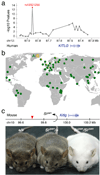A molecular basis for classic blond hair color in Europeans
- PMID: 24880339
- PMCID: PMC4704868
- DOI: 10.1038/ng.2991
A molecular basis for classic blond hair color in Europeans
Abstract
Hair color differences are among the most obvious examples of phenotypic variation in humans. Although genome-wide association studies (GWAS) have implicated multiple loci in human pigment variation, the causative base-pair changes are still largely unknown. Here we dissect a regulatory region of the KITLG gene (encoding KIT ligand) that is significantly associated with common blond hair color in northern Europeans. Functional tests demonstrate that the region contains a regulatory enhancer that drives expression in developing hair follicles. This enhancer contains a common SNP (rs12821256) that alters a binding site for the lymphoid enhancer-binding factor 1 (LEF1) transcription factor, reducing LEF1 responsiveness and enhancer activity in cultured human keratinocytes. Mice carrying ancestral or derived variants of the human KITLG enhancer exhibit significant differences in hair pigmentation, confirming that altered regulation of an essential growth factor contributes to the classic blond hair phenotype found in northern Europeans.
Figures





Comment in
-
The secret of a natural blond.Nat Genet. 2014 Jul;46(7):660-1. doi: 10.1038/ng.3019. Nat Genet. 2014. PMID: 24965725
-
Highlighting blondes: a tissue-specific KITLG enhancer shows us how.Pigment Cell Melanoma Res. 2014 Nov;27(6):1007-8. doi: 10.1111/pcmr.12311. Epub 2014 Sep 17. Pigment Cell Melanoma Res. 2014. PMID: 25169654 No abstract available.
References
-
- Sturm RA. Molecular genetics of human pigmentation diversity. Hum. Mol. Genet. 2009;18:R9–R17. - PubMed
-
- Sulem P, et al. Genetic determinants of hair, eye and skin pigmentation in Europeans. Nat. Genet. 2007;39:1443–1452. - PubMed
-
- Cruz-Inigo AE, Ladizinski B, Sethi A. Albinism in Africa: stigma, slaughter and awareness campaigns. Dermatol. Clin. 2011;29:79–87. - PubMed
-
- Pitman J. On Blondes. New York: Bloomsbury Publishing; 2003.
-
- The Iliad of Homer. Chicago: The University of Chicago Press; 2011.
Publication types
MeSH terms
Substances
Grants and funding
LinkOut - more resources
Full Text Sources
Other Literature Sources
Molecular Biology Databases
Research Materials

